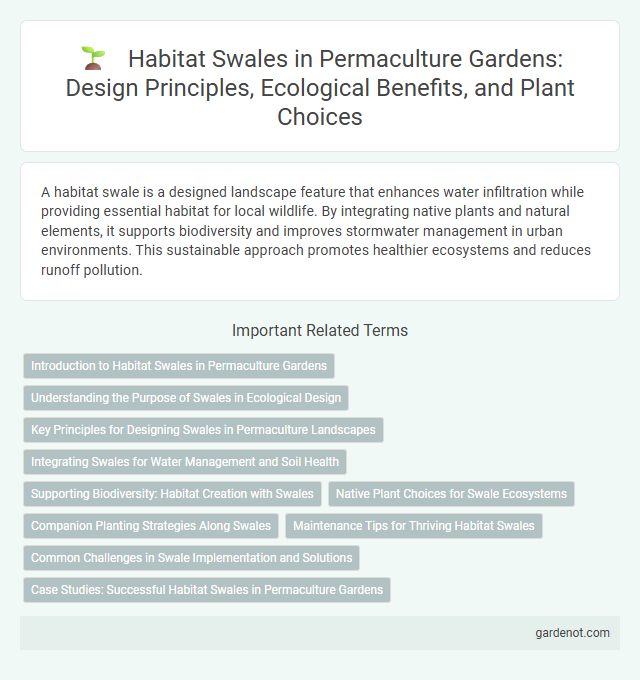A habitat swale is a designed landscape feature that enhances water infiltration while providing essential habitat for local wildlife. By integrating native plants and natural elements, it supports biodiversity and improves stormwater management in urban environments. This sustainable approach promotes healthier ecosystems and reduces runoff pollution.
Introduction to Habitat Swales in Permaculture Gardens
Habitat swales in permaculture gardens serve as strategically designed earthworks that capture and retain rainwater, promoting soil moisture retention and reducing erosion. These swales support diverse plant and microbial life, creating microhabitats essential for sustaining local biodiversity and enhancing ecosystem resilience. By integrating native vegetation and organic mulch, habitat swales improve soil health and provide critical habitats for pollinators, amphibians, and beneficial insects within sustainable garden systems.
Understanding the Purpose of Swales in Ecological Design
Swales function as shallow, vegetated channels designed to manage stormwater runoff, enhance groundwater recharge, and reduce soil erosion in ecological design. By slowing and filtering water flow, habitat swales create vital microhabitats for native flora and fauna, supporting biodiversity and improving water quality. Incorporating swales in sustainable landscapes optimizes natural water cycles and fosters resilient ecosystems.
Key Principles for Designing Swales in Permaculture Landscapes
Swales in permaculture landscapes are designed to capture and slow water runoff, promoting soil infiltration and reducing erosion. Key principles include contour alignment to follow natural land gradients, employing broad, shallow channels for maximum water absorption, and integrating diverse plantings to enhance biodiversity and soil health. Incorporating mulch and organic matter further improves water retention and supports ecosystem resilience within the swale system.
Integrating Swales for Water Management and Soil Health
Habitat swales enhance water management by capturing and gradually infiltrating stormwater, reducing runoff and recharging groundwater. Integrating swales into landscapes improves soil health through increased moisture retention and nutrient cycling, promoting biodiversity and supporting native plant growth. These green infrastructures mitigate erosion, filter pollutants, and create microhabitats that sustain local wildlife populations.
Supporting Biodiversity: Habitat Creation with Swales
Swales play a critical role in supporting biodiversity by creating diverse habitats that foster native plant species and provide shelter for insects, birds, and small mammals. These linear landscape features manage stormwater while promoting ecological connectivity, allowing wildlife to thrive in urban and suburban environments. Integrating swales into green infrastructure enhances habitat complexity and contributes to the restoration of natural ecosystems.
Native Plant Choices for Swale Ecosystems
Native plant choices for habitat swales include deep-rooted grasses, sedges, and wildflowers such as Carex species, Echinacea purpurea, and Asclepias tuberosa, which enhance water infiltration and support local wildlife. These plants are adapted to fluctuating moisture levels, promoting soil stabilization and nutrient cycling within the swale ecosystem. Incorporating diverse native species increases habitat complexity, benefiting pollinators, amphibians, and bird populations.
Companion Planting Strategies Along Swales
Companion planting strategies along habitat swales enhance biodiversity and pest control by selecting plant species that mutually benefit each other in soil stabilization and nutrient cycling. Incorporating nitrogen-fixing legumes alongside deep-rooted perennials improves soil fertility and water retention in swale systems. Strategic plant combinations such as native grasses with pollinator-friendly flowering plants optimize habitat resilience and support local fauna within swale environments.
Maintenance Tips for Thriving Habitat Swales
Regular removal of invasive weeds and sediment buildup ensures optimal water infiltration and native plant health in habitat swales. Periodic inspection of swale banks and vegetation density supports erosion control and promotes habitat diversity. Implementing seasonal pruning and replanting native species enhances biodiversity and sustains ecological functions within habitat swales.
Common Challenges in Swale Implementation and Solutions
Common challenges in habitat swale implementation include maintaining proper water flow to prevent stagnation, managing invasive plant species, and ensuring soil stability to avoid erosion. Effective solutions involve selecting native, water-tolerant vegetation to enhance biodiversity and filtration, installing perforated drains or check dams to control water movement, and reinforcing banks with coir mats or rock armoring to improve structural integrity. Regular monitoring and adaptive management strategies help address these issues while promoting the ecological function of habitat swales.
Case Studies: Successful Habitat Swales in Permaculture Gardens
Habitat swales have proven highly effective in permaculture gardens by enhancing water retention and supporting biodiversity, as demonstrated in multiple case studies. Notable examples include the food forest at Zaytuna Farm in Australia, where swales have increased soil fertility and promoted native plant growth. Similarly, the permaculture design at Oregon State University's Garden utilizes habitat swales to restore ecosystem functions, improving habitat for beneficial insects and native wildlife.
Habitat swale Infographic

 gardenot.com
gardenot.com